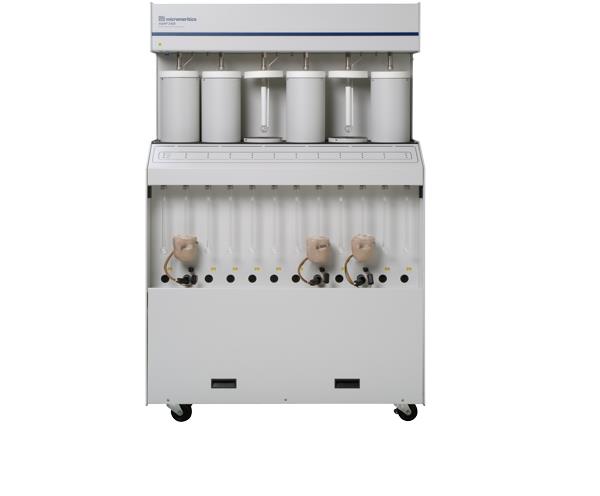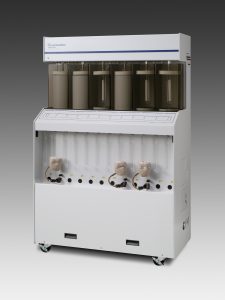
Specifications
ASAP 2420
Accelerated Surface Area and Porosimetry System
Micromeritics ASAP® 2420 Accelerated Surface Area and Porosimetry System uses the gas sorption technique to generate high-quality data for applications that require high performance/high sample throughput. Standard features include six independently operated analysis ports and a programmable and fully automated sample preparation module with twelve independently operated ports.
Features
High Performance - High Throughput
The ASAP 2420 system is designed to help today’s busy laboratories expand their work flow while providing highly-accurate and precise surface area and porosimetry data. High-performance and versatile analysis and sample preparation systems are included in the same instrument.
| Advantages:
✔ Fully automated analyses ✔ High throughput with six independent analysis stations ✔ Each analysis port has a dedicated analysis and P0 pressure transducer ✔ Twelve independently controlled degas ports ✔ Evacuation rate precisely regulated by a servo valve ✔ BET surface area measurements in as little as 30 minutes
|
✔ Dosing options of maximum volume increment or dosing over specified pressure ranges
✔ Analysis temperature can be entered, calculated, or measured ✔ Equilibration option allows user to specify equilibration times for different parts of the isotherm ✔ Low surface area option with five independent analysis ports ✔ Windows-driven software |
Analysis System
With six independently operated analysis ports, a new analysis can begin as soon as another is finished. This provides an important advantage over many multiport instruments that require all samples to be prepared or analyzed at the same time.
- Extended analyses can be performed without refilling the Dewar. This allows unattended analysis of high resolution adsorption/desorption isotherms.
- BET surface area analyses utilizing six parallel runs can be achieved in as little as 30 minutes.
- The system allows dosing options of maximum volume increment or dosing over specified pressure ranges.
- The analysis temperature can be entered, calculated, or measured.
- Long-duration Dewars and patented Isothermal Jackets assure a constant thermal profile along the length of both the sample and saturation pressure (P0) tubes during the analyses. The P0value may be entered, or measured either continuously or at selected intervals.
- The equilibration interval is user specified and enhanced to allow the user to define equilibration intervals for different parts of the isotherm.
- A low surface area option that uses krypton as an adsorptive to measure total surface areas of 5 m2 or less is available. This option features a turbo-molecular drag pump, which provides the high vacuum required for krypton analyses, and a 10-mmHg pressure transducer, which allows accurate, repeatable pressure resolution. This option utilizes five of the six available sample ports.
- In addition to controlling the instrument’s operation, powerful Windows software also reduces the raw data collected during the analysis. The reduced data can be reviewed or printed in a variety of easy-to-interpret tabular and graphical reports.
- Optional Confirm 21 CFR Part 11 software assists with compliance to FDA regulations. IQ and OQ services help assure that the system is validated for proper installation, accuracy, and consistent performance.
Sample Preparation System
- The ASAP 2420 system includes twelve automatically controlled sample preparation ports that operate independently. Samples may be added or removed from degas ports without disturbing the treatment of other samples undergoing preparation or analysis.
- The sample preparation system is fully automated with controlled heating time profiles. The temperature and ramp rate can be set and monitored individually and controlled from a few degrees above ambient to 450 oC. The temperature hold period may extend past the point when evacuation is completed.
- A programmable pressure threshold can suspend the temperature ramp if the out-gassing pressure exceeds the limit specified, preventing destructive steaming or other undesired reactions with residual gases and vapors







